Peng Jia
The Better You Learn, The Smarter You Prune: Towards Efficient Vision-language-action Models via Differentiable Token Pruning
Sep 16, 2025Abstract:We present LightVLA, a simple yet effective differentiable token pruning framework for vision-language-action (VLA) models. While VLA models have shown impressive capability in executing real-world robotic tasks, their deployment on resource-constrained platforms is often bottlenecked by the heavy attention-based computation over large sets of visual tokens. LightVLA addresses this challenge through adaptive, performance-driven pruning of visual tokens: It generates dynamic queries to evaluate visual token importance, and adopts Gumbel softmax to enable differentiable token selection. Through fine-tuning, LightVLA learns to preserve the most informative visual tokens while pruning tokens which do not contribute to task execution, thereby improving efficiency and performance simultaneously. Notably, LightVLA requires no heuristic magic numbers and introduces no additional trainable parameters, making it compatible with modern inference frameworks. Experimental results demonstrate that LightVLA outperforms different VLA models and existing token pruning methods across diverse tasks on the LIBERO benchmark, achieving higher success rates with substantially reduced computational overhead. Specifically, LightVLA reduces FLOPs and latency by 59.1% and 38.2% respectively, with a 2.9% improvement in task success rate. Meanwhile, we also investigate the learnable query-based token pruning method LightVLA* with additional trainable parameters, which also achieves satisfactory performance. Our work reveals that as VLA pursues optimal performance, LightVLA spontaneously learns to prune tokens from a performance-driven perspective. To the best of our knowledge, LightVLA is the first work to apply adaptive visual token pruning to VLA tasks with the collateral goals of efficiency and performance, marking a significant step toward more efficient, powerful and practical real-time robotic systems.
Generalizable Engagement Estimation in Conversation via Domain Prompting and Parallel Attention
Aug 20, 2025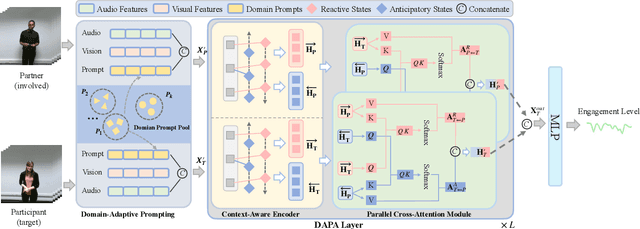
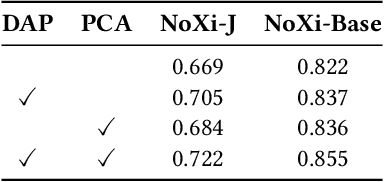
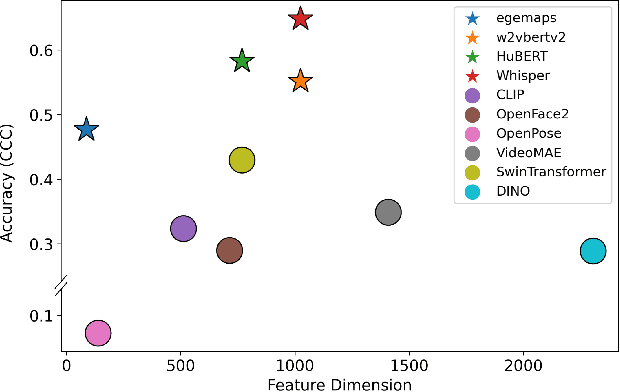
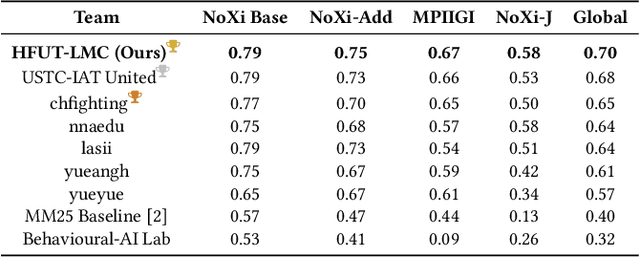
Abstract:Accurate engagement estimation is essential for adaptive human-computer interaction systems, yet robust deployment is hindered by poor generalizability across diverse domains and challenges in modeling complex interaction dynamics.To tackle these issues, we propose DAPA (Domain-Adaptive Parallel Attention), a novel framework for generalizable conversational engagement modeling. DAPA introduces a Domain Prompting mechanism by prepending learnable domain-specific vectors to the input, explicitly conditioning the model on the data's origin to facilitate domain-aware adaptation while preserving generalizable engagement representations. To capture interactional synchrony, the framework also incorporates a Parallel Cross-Attention module that explicitly aligns reactive (forward BiLSTM) and anticipatory (backward BiLSTM) states between participants.Extensive experiments demonstrate that DAPA establishes a new state-of-the-art performance on several cross-cultural and cross-linguistic benchmarks, notably achieving an absolute improvement of 0.45 in Concordance Correlation Coefficient (CCC) over a strong baseline on the NoXi-J test set. The superiority of our method was also confirmed by winning the first place in the Multi-Domain Engagement Estimation Challenge at MultiMediate'25.
DriveAction: A Benchmark for Exploring Human-like Driving Decisions in VLA Models
Jun 06, 2025Abstract:Vision-Language-Action (VLA) models have advanced autonomous driving, but existing benchmarks still lack scenario diversity, reliable action-level annotation, and evaluation protocols aligned with human preferences. To address these limitations, we introduce DriveAction, the first action-driven benchmark specifically designed for VLA models, comprising 16,185 QA pairs generated from 2,610 driving scenarios. DriveAction leverages real-world driving data proactively collected by users of production-level autonomous vehicles to ensure broad and representative scenario coverage, offers high-level discrete action labels collected directly from users' actual driving operations, and implements an action-rooted tree-structured evaluation framework that explicitly links vision, language, and action tasks, supporting both comprehensive and task-specific assessment. Our experiments demonstrate that state-of-the-art vision-language models (VLMs) require both vision and language guidance for accurate action prediction: on average, accuracy drops by 3.3% without vision input, by 4.1% without language input, and by 8.0% without either. Our evaluation supports precise identification of model bottlenecks with robust and consistent results, thus providing new insights and a rigorous foundation for advancing human-like decisions in autonomous driving.
GeoDrive: 3D Geometry-Informed Driving World Model with Precise Action Control
May 29, 2025Abstract:Recent advancements in world models have revolutionized dynamic environment simulation, allowing systems to foresee future states and assess potential actions. In autonomous driving, these capabilities help vehicles anticipate the behavior of other road users, perform risk-aware planning, accelerate training in simulation, and adapt to novel scenarios, thereby enhancing safety and reliability. Current approaches exhibit deficiencies in maintaining robust 3D geometric consistency or accumulating artifacts during occlusion handling, both critical for reliable safety assessment in autonomous navigation tasks. To address this, we introduce GeoDrive, which explicitly integrates robust 3D geometry conditions into driving world models to enhance spatial understanding and action controllability. Specifically, we first extract a 3D representation from the input frame and then obtain its 2D rendering based on the user-specified ego-car trajectory. To enable dynamic modeling, we propose a dynamic editing module during training to enhance the renderings by editing the positions of the vehicles. Extensive experiments demonstrate that our method significantly outperforms existing models in both action accuracy and 3D spatial awareness, leading to more realistic, adaptable, and reliable scene modeling for safer autonomous driving. Additionally, our model can generalize to novel trajectories and offers interactive scene editing capabilities, such as object editing and object trajectory control.
TransDiffuser: End-to-end Trajectory Generation with Decorrelated Multi-modal Representation for Autonomous Driving
May 14, 2025Abstract:In recent years, diffusion model has shown its potential across diverse domains from vision generation to language modeling. Transferring its capabilities to modern autonomous driving systems has also emerged as a promising direction.In this work, we propose TransDiffuser, an encoder-decoder based generative trajectory planning model for end-to-end autonomous driving. The encoded scene information serves as the multi-modal conditional input of the denoising decoder. To tackle the mode collapse dilemma in generating high-quality diverse trajectories, we introduce a simple yet effective multi-modal representation decorrelation optimization mechanism during the training process.TransDiffuser achieves PDMS of 94.85 on the NAVSIM benchmark, surpassing previous state-of-the-art methods without any anchor-based prior trajectories.
PosePilot: Steering Camera Pose for Generative World Models with Self-supervised Depth
May 03, 2025Abstract:Recent advancements in autonomous driving (AD) systems have highlighted the potential of world models in achieving robust and generalizable performance across both ordinary and challenging driving conditions. However, a key challenge remains: precise and flexible camera pose control, which is crucial for accurate viewpoint transformation and realistic simulation of scene dynamics. In this paper, we introduce PosePilot, a lightweight yet powerful framework that significantly enhances camera pose controllability in generative world models. Drawing inspiration from self-supervised depth estimation, PosePilot leverages structure-from-motion principles to establish a tight coupling between camera pose and video generation. Specifically, we incorporate self-supervised depth and pose readouts, allowing the model to infer depth and relative camera motion directly from video sequences. These outputs drive pose-aware frame warping, guided by a photometric warping loss that enforces geometric consistency across synthesized frames. To further refine camera pose estimation, we introduce a reverse warping step and a pose regression loss, improving viewpoint precision and adaptability. Extensive experiments on autonomous driving and general-domain video datasets demonstrate that PosePilot significantly enhances structural understanding and motion reasoning in both diffusion-based and auto-regressive world models. By steering camera pose with self-supervised depth, PosePilot sets a new benchmark for pose controllability, enabling physically consistent, reliable viewpoint synthesis in generative world models.
Adaptive Detection of Fast Moving Celestial Objects Using a Mixture of Experts and Physical-Inspired Neural Network
Apr 10, 2025Abstract:Fast moving celestial objects are characterized by velocities across the celestial sphere that significantly differ from the motions of background stars. In observational images, these objects exhibit distinct shapes, contrasting with the typical appearances of stars. Depending on the observational method employed, these celestial entities may be designated as near-Earth objects or asteroids. Historically, fast moving celestial objects have been observed using ground-based telescopes, where the relative stability of stars and Earth facilitated effective image differencing techniques alongside traditional fast moving celestial object detection and classification algorithms. However, the growing prevalence of space-based telescopes, along with their diverse observational modes, produces images with different properties, rendering conventional methods less effective. This paper presents a novel algorithm for detecting fast moving celestial objects within star fields. Our approach enhances state-of-the-art fast moving celestial object detection neural networks by transforming them into physical-inspired neural networks. These neural networks leverage the point spread function of the telescope and the specific observational mode as prior information; they can directly identify moving fast moving celestial objects within star fields without requiring additional training, thereby addressing the limitations of traditional techniques. Additionally, all neural networks are integrated using the mixture of experts technique, forming a comprehensive fast moving celestial object detection algorithm. We have evaluated our algorithm using simulated observational data that mimics various observations carried out by space based telescope scenarios and real observation images. Results demonstrate that our method effectively detects fast moving celestial objects across different observational modes.
TokenFLEX: Unified VLM Training for Flexible Visual Tokens Inference
Apr 04, 2025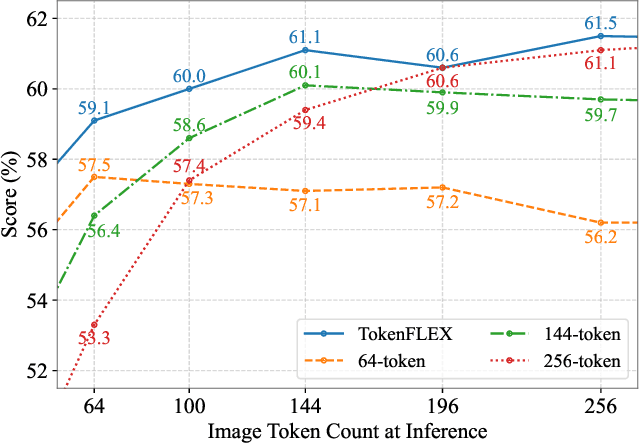
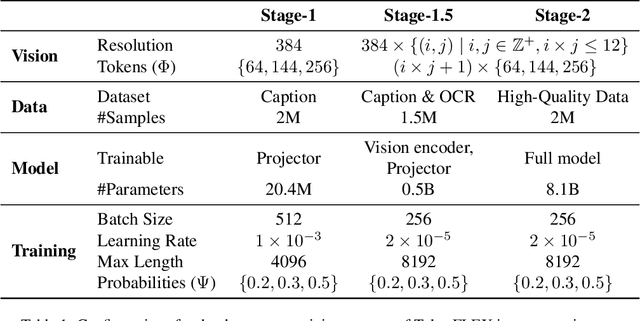
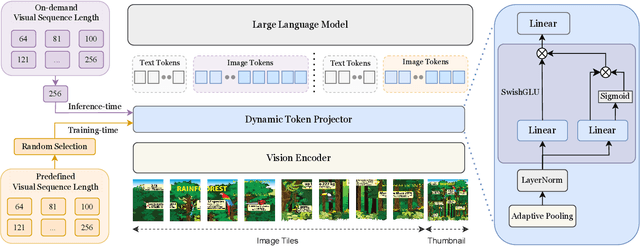
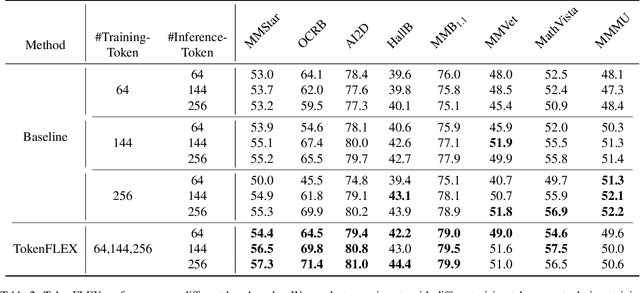
Abstract:Conventional Vision-Language Models(VLMs) typically utilize a fixed number of vision tokens, regardless of task complexity. This one-size-fits-all strategy introduces notable inefficiencies: using excessive tokens leads to unnecessary computational overhead in simpler tasks, whereas insufficient tokens compromise fine-grained visual comprehension in more complex contexts. To overcome these limitations, we present TokenFLEX, an innovative and adaptable vision-language framework that encodes images into a variable number of tokens for efficient integration with a Large Language Model (LLM). Our approach is underpinned by two pivotal innovations. Firstly, we present a novel training paradigm that enhances performance across varying numbers of vision tokens by stochastically modulating token counts during training. Secondly, we design a lightweight vision token projector incorporating an adaptive pooling layer and SwiGLU, allowing for flexible downsampling of vision tokens and adaptive selection of features tailored to specific token counts. Comprehensive experiments reveal that TokenFLEX consistently outperforms its fixed-token counterparts, achieving notable performance gains across various token counts enhancements of 1.6%, 1.0%, and 0.4% with 64, 144, and 256 tokens, respectively averaged over eight vision-language benchmarks. These results underscore TokenFLEX's remarkable flexibility while maintaining high-performance vision-language understanding.
VISTA: Unsupervised 2D Temporal Dependency Representations for Time Series Anomaly Detection
Apr 03, 2025Abstract:Time Series Anomaly Detection (TSAD) is essential for uncovering rare and potentially harmful events in unlabeled time series data. Existing methods are highly dependent on clean, high-quality inputs, making them susceptible to noise and real-world imperfections. Additionally, intricate temporal relationships in time series data are often inadequately captured in traditional 1D representations, leading to suboptimal modeling of dependencies. We introduce VISTA, a training-free, unsupervised TSAD algorithm designed to overcome these challenges. VISTA features three core modules: 1) Time Series Decomposition using Seasonal and Trend Decomposition via Loess (STL) to decompose noisy time series into trend, seasonal, and residual components; 2) Temporal Self-Attention, which transforms 1D time series into 2D temporal correlation matrices for richer dependency modeling and anomaly detection; and 3) Multivariate Temporal Aggregation, which uses a pretrained feature extractor to integrate cross-variable information into a unified, memory-efficient representation. VISTA's training-free approach enables rapid deployment and easy hyperparameter tuning, making it suitable for industrial applications. It achieves state-of-the-art performance on five multivariate TSAD benchmarks.
StyledStreets: Multi-style Street Simulator with Spatial and Temporal Consistency
Mar 27, 2025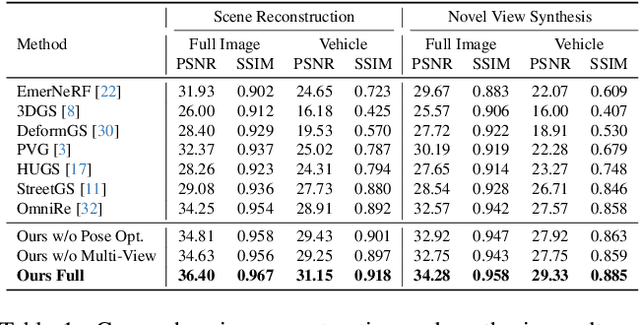
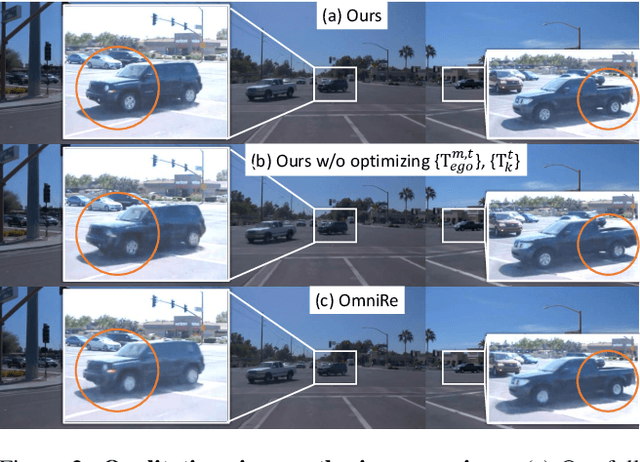
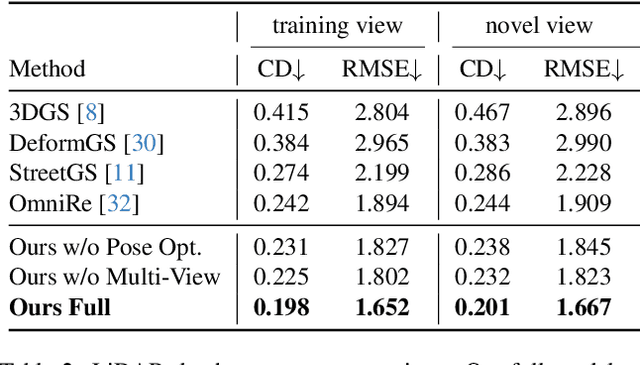
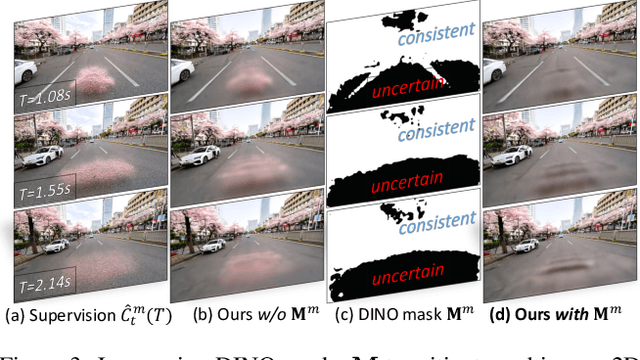
Abstract:Urban scene reconstruction requires modeling both static infrastructure and dynamic elements while supporting diverse environmental conditions. We present \textbf{StyledStreets}, a multi-style street simulator that achieves instruction-driven scene editing with guaranteed spatial and temporal consistency. Building on a state-of-the-art Gaussian Splatting framework for street scenarios enhanced by our proposed pose optimization and multi-view training, our method enables photorealistic style transfers across seasons, weather conditions, and camera setups through three key innovations: First, a hybrid embedding scheme disentangles persistent scene geometry from transient style attributes, allowing realistic environmental edits while preserving structural integrity. Second, uncertainty-aware rendering mitigates supervision noise from diffusion priors, enabling robust training across extreme style variations. Third, a unified parametric model prevents geometric drift through regularized updates, maintaining multi-view consistency across seven vehicle-mounted cameras. Our framework preserves the original scene's motion patterns and geometric relationships. Qualitative results demonstrate plausible transitions between diverse conditions (snow, sandstorm, night), while quantitative evaluations show state-of-the-art geometric accuracy under style transfers. The approach establishes new capabilities for urban simulation, with applications in autonomous vehicle testing and augmented reality systems requiring reliable environmental consistency. Codes will be publicly available upon publication.
 Add to Chrome
Add to Chrome Add to Firefox
Add to Firefox Add to Edge
Add to Edge